Besieged Castle: The Human Body
It is a fact that even though we try to live in clean environments, we share these places with many micro-organisms. If you had the chance to view the room you are currently sitting in with a microscope, you would immediately see the millions of organisms you live with.
In this situation, the individual resembles a "besieged castle". Needless to say, such a castle, which is surrounded by countless enemies, must be protected in a very complete and organized manner. Human beings are created along with this perfect protection they need, and are not, therefore, entirely defenceless against these enemies. The "micro" guards in our bodies never leave us alone and fight for us on many fronts.
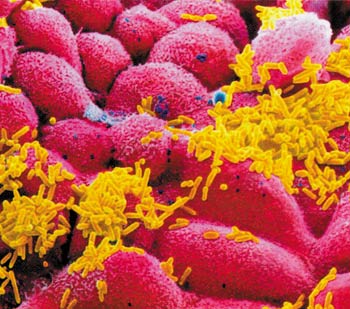 |  |
| Masses of influenza bacteria on the nasal epithelium | Bacteria on a recently brushed tooth |
The invader cells that want to take control of the body first have to fight their way through the front line of the body. Even though these fronts have their weaknesses at times, the enemy is hardly ever allowed to pass through them. The first front the enemy must penetrate is our skin.
Microscopic Monsters | |
 | 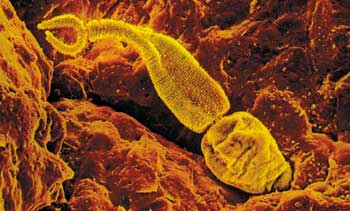 |
| Left: The "dust mite" is only one of the millions of organisms with which humans live with but cannot see. Above: A parasite larva while breaching the human skin. This organism will make its way to the blood stream through the skin, and settle into the vessels to multiply. It uses incredible tactics to escape from the body's army of defence, such as camouflaging itself with the material it rips off from the host cell. | |
The Protective Armour of Our Body: The Skin
The skin, which covers the entire body of a human being just like a sheath, is full of amazing features. Its ability to repair and renew itself, its non-permeability by water, despite the existence of tiny pores on its surface as opposed to its function of discharging water through perspiration, its extremely flexible structure, allowing free movement, as opposed to its being thick enough to avoid easy rupture, its ability to protect the body from the heat, the cold, and harmful sunrays are only a few of the features of the skin that have been specially created for human beings. Here, we will deal with a particular feature of this extraordinary wrapping paper: its ability to protect the body from disease-causing micro-organisms. If the body is considered a castle besieged by enemies, we can safely refer to the skin as the strong walls of this castle.
 |
| The first defense response of the organism against its dangerous invaders is the rapid self-repairing of the skin tissue following the infliction of a wound. When such a wound ruptures the skin, defence cells immediately travel to the injured area to fight with the foreign cell and to remove the debris of the affected tissue. Later, some other defence cells enhance the production of fibrin, which is a protein that rapidly re-covers the wound with a fibrous network. This picture is of a fibrin that has spread over some red blood cells. |
The main protective function of the skin is realized via the dead cell layers constituting the outer section of the skin. Each new cell produced by cell division moves from the inner section of the skin towards the surface. While doing this, the liquid element (cytoplasm) of the cell interior transforms into a resistant protein known as keratin. During the process, the cell dies. The newly formed keratin substance has a very hard structure and is not therefore subject to decomposition by digestive enzymes, which is a sign of its resistance. Thus, invaders such as bacteria and fungi will be unable to find anything to rip off from the outer layer of the skin.
Moreover, dead outer cells containing keratin are constantly shed from the skin surface. The new cells that come from beneath to replace the discarded ones form an impenetrable barrier in that area.
 | |||
| 1. Epidermis | 6. Subcutaneous Fat | 11. Sweat Duct | 16. Hair follicle |
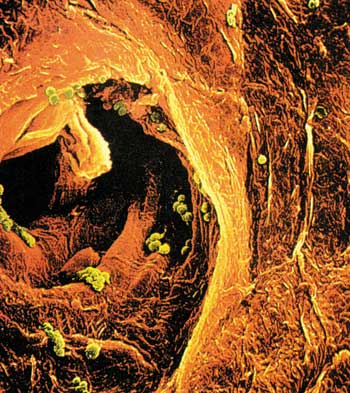 | An in-Depth View of the Skin | ||
| Above is a cross-section of the skin. The sweat droplets secreted from the skin play a variety of roles in the body. In addition bringing down the body temperature, they provide nutrition for certain bacteria and fungi living on the surface of the skin, and produce acidic waste materials such as lactic acid which helps decrease the PH level of the skin. This acidic medium on the skin surface creates a hostile environment for any harmful bacteria that are looking for a place to live. At the left is a close-up of the sweat gland entrance. Here, too, you will find bacteria just like everywhere else on the skin. | |||
The organisms on the skin fulfill another protective function of the skin. A group of harmless microbes live on the skin, which have adapted to its acidic medium. Feeding on the leftovers stuck on the keratin of the skin, these microbes attack all kinds of foreign bodies to protect their feeding site. The skin, as the host of these microbes, is like a supplementary force that provides external support to the army within the human body.
Protection in Respiration
One of the courses our enemies take to enter our body is the respiratory tract. Hundreds of varied microbes, which are present in the air we inhale, try to gain entry to the body through these passages. However, they are unaware of the barrier set up against them in the nose.
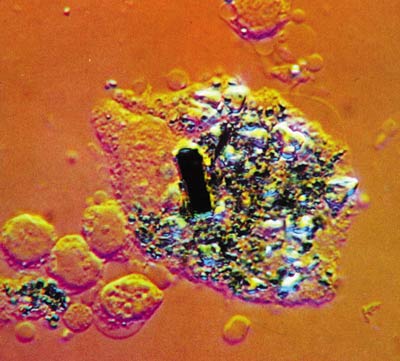 | 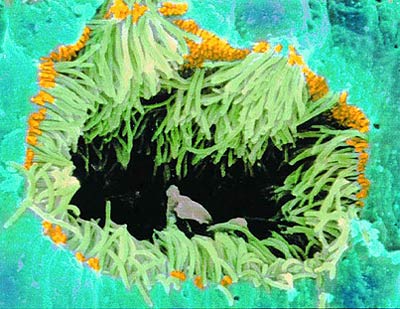 |
| In this picture, you can see the macrophages located in the lungtissues. They eliminate the dust particles in the air we inhale. | This picture, which is magnified 5900 times, shows the cells in the trachea (blue). They use their glands (yellow) to secrete a substance that traps the particles in the air. |
A special secretion in the nasal mucous retains and sweeps out about 80-90% of the micro-organisms that gain entry to the respiratory system directly or through dust particles or other substances.
In addition, the tiny hairlike structures (cilia) on the surface of the cells of the respiratory tract beat upward, causing a current that carries foreign particles to the throat where they are swallowed and disposed of by acid in the stomach. The coughing reflex and sneezing facilitate this function.
The microbes that are able to surmount these barriers and reach the alveoli (lung, bronchus and gingiva) will be ingested by phagocytes. After this phase, phagocytes become mobile and drift upwards with the microbes they have ingested to be finally discharged from the body in different ways.
Each time you breathe, as you are doing now, a war is fought at the border gates of your body of which you are completely unaware. The guards at these border gates fight with the enemy to the death to protect your health.
Protection in the Digestive System
Another vehicle by which microbes gain entry to our body is our food. However, the guards of our body, which are aware of this method used by the microbes, await them in the region where the food finally ends up, which is the stomach. They also have a surprise for the arriving microbes, which is the gastric acid. This acid is quite an unpleasant surprise for the microbes which have overcome all obstacles and reached the stomach. The majority, if not all, of the microbes are defeated by this acid.
Some microbes may overcome this obstacle because they have not made enough contact with the gastric acid, or they have showed resistance. However, these microbes are again subjected to further conflicts with other guards situated on their way. Now, another surprise is at hand for them: the digestive enzymes produced in the small intestine. This time, they cannot get away as easily.
As we have seen, the human body has specially created guards, which protect the human body in every phase of the microbes’ assaults.
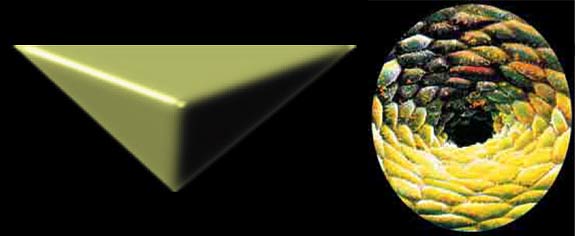 |
| This picture, which is magnified 865 times, shows a gastric gland hole (entry) in the mucous lining. |
There are now some important questions raised by this examination.
Who established that microbes living outside would try to penetrate our body through foods, which route the food would follow, how microbes would be destroyed in their final destination, where they would go if they overcame this obstacle, and how in that case they should be exposed to stronger measures? Is it the body cells, which have never been out of the body, and therefore, have no chance of examining the chemical make-up of the microbes outside, and which, moreover, have not received any training in chemistry?
Definitely not. Only Allah, Who created both the external world, and the food in this world, and the body that needs these foods, and the system to digest these foods, is able to create such a defence system.
Another Method: Destroying the Enemy by Another Enemy
There are many other micro-organisms that live within the human body which cause us no harm. What are these organisms that continue with their own life without doing us any harm, and what is their purpose in living within our body?
These groups of micro-organisms, which are gathered in certain parts of the body, are called the normal microbial flora of the body. They do no damage and even have some benefits for the human body.
These micro-organisms provide external support for the defence army against microbes. They benefit the body by preventing foreign microbes from settling in it, because the entry of any microbe into the body is a threat to their own housing site. Since they do not want to be displaced by the invaders, they fight a fierce battle against them. We can think of these micro-organisms as "professional soldiers" fighting for the body. They try to protect the site they live in for their own benefit. In so doing, they complement the fully equipped army in our body.
How do these "professional soldiers" settle in our bodies?
The human embryo has met no enemy during the gestation period in the mother’s womb. Following the birth of the child, it makes contact with the environment, and numerous microbes are introduced to the child through the intake of food and by way of the respiratory tract. Some of these microbes die right away, while others are discharged before having the chance to settle down in the body. Some, however, settle in various parts of the body such as the skin, skin ridges, mouth, nose, eyes, upper respiratory tract, digestive tract, and genital organs. These microbes form permanent colonies at these locations and constitute the microbial flora of the human body.
Who Are Our Micro Enemies?
Our micro enemies, on the other hand, are micro-organisms, which are not a part of our bodies, yet which have somehow penetrated our bodies, eventually stimulating the defence army therein.
Every foreign cell that enters the body is not, however treated as an enemy. Foreign matter constantly enters our bodies as we eat, drink water, or take medicine. Yet our body does not initiate a war with it. In order for the defence cells to perceive a foreign substance as an enemy, certain conditions are taken into consideration such as the size of the molecule, its rate of elimination from the body, and its way of entering the body.
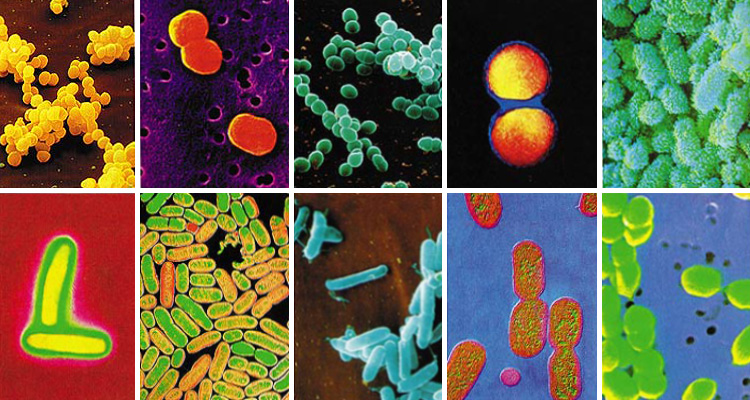 |
| There are hundreds of bacteria in the world. In the above picture, you can see only a few of them. |
Bacteria
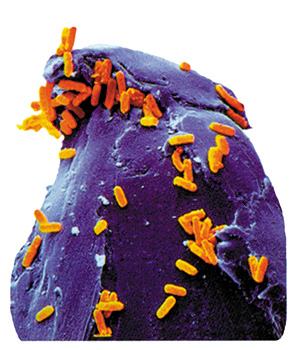 |
| The magnified view of bacteria on the tip of needle. |
Among our innumerable micro enemies, bacteria have an established reputation.
Bacteria, which enter the human body in multiple ways, instigate a fierce war in the body. Sometimes ending up with quite serious illnesses, these wars explicitly reveal the power and ability hidden in an organism the size of a few microns (a micron is one thousandth of a millimeter). Recent research has shown that bacteria have an extraordinary resistance even to the most severe and harsh conditions. Particularly, the bacteria known as spores are resistant to extremely high temperatures and drought for extended periods. This is why it is difficult to destroy certain microbes.
Viruses
The human body resembles a very valuable diamond stored in a safe, receiving the most intensive care and protection. Some of the organisms that try to invade the body act like experienced thieves. One of the best known and most important of these thieves is the virus.
This organism, whose existence we became aware of with the invention of the electron microscope, is too simple-structured and small to be considered even as a cell. Viruses, which vary in sizes ranging from 0.1 to 0.280 microns, are excluded from the world of living things for this reason. 2
 |
| A virus modifying its structure so that it is not identified by the immune system. (The rhinovirus 14) |
Although categorized as being apart from the world of living beings, viruses indisputably possess at least as exceptional abilities as all other living beings do. A closer examination of the lives of viruses will make this fact more apparent. Viruses are the compulsory parasites of living beings. This means, they cannot survive if they do not settle into a plant, animal, or human cell, and consume its food and energy. Viruses do not have a system that would enable them to survive on their own. As if they are aware of this, they deftly slip into a cell, and after invading the cell, with the same deftness turn the cell into a "virus production factory" that produces its own copies.
This plan developed by the virus to invade the cell is extremely sophisticated and intelligent. In the first place, the virus must determine whether the cell is appropriate for itself or not. It has to be very careful and meticulous in this decision, for the smallest mistake may cause its death. To avoid such an end, it uses its special receptors to check whether the cell is appropriate for it or not. The next important thing it does is to carefully locate itself within the cell.
The virus confuses the cell with the tactics it employs and avoids observation.
This is how the events develop: the cell transports the new DNA of the virus into its nucleus. Thinking that it produces protein, the cell starts to replicate this new DNA. The DNA of the virus hides itself so furtively that the cell involuntarily becomes the production factory of its own enemy and produces the very viruses that will eventually destroy it. It is indeed very difficult for the cell to identify the hereditary make-up of the virus as that of an invader.
The virus locates itself within the cell so well that it almost becomes a part of it. After the multiplication process is over, the virus and other new viruses depart from the cell to repeat the same process in other cells. During the process, depending on the type of the virus and the cell, the virus can kill the host cell, cause harm to it, modify it, or simply do nothing.
The question of how the cell, which operates under a very strictly monitored control mechanism, can be deceived into becoming a virus factory is still unanswered. It is quite intriguing that viruses, which have a highly specialized structure, but which are not even classified as living beings, could act so intelligently, think up, and plan such effective strategies. The secret of this phenomenon lies in the existence of a Creator, Who created these organisms with the abilities they possess.
The features of the virus are perfectly designed to enable it to make use of the system operating in the cell. It is obvious that the power that created the virus is also well informed about the extremely complex working principles of the cell. This power belongs to Allah, Who created the virus and the cell into which it will settle, as He created the entire universe.
The virus, which, with its miniscule structure, can inflict and sometimes even cause the death of the human body, which is millions of times bigger than itself in size, is a being specially created by Allah to remind people of their weaknesses.
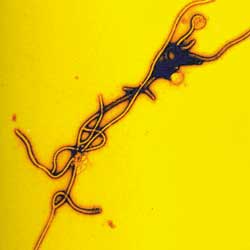 | 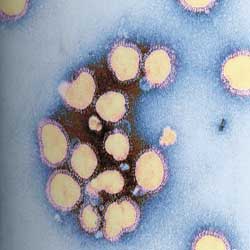 | 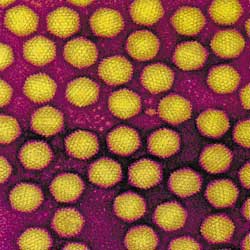 |
| Ebola Virus | Influenza Virus | Common Cold Virus |
Footnotes
2. George Gamow, One Two Three... Infinity, Bantam Books, 1971, p. 245
